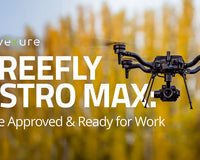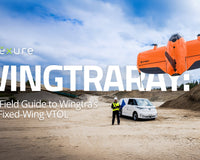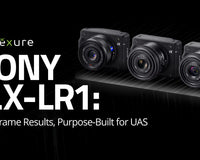It was just a few days ago that we learned that today, December 15th, DJI Enterprise would unveil an all new model in the Mavic 2 Enterprise (M2E) line-up – the new DJI Mavic 2 Enterprise Advanced. DJI's M2E lineup, which prior to the release of the Advanced, consisted of the Dual and Zoom models. These aircraft have been incredibly common amongst Advexure's partners in public safety, inspection, critical infrastructure, utilities and many other industry sectors. In spring of 2020, Autel Robotics brought out the Autel EVO II Dual which quickly became a go-to platform for many users given its small form factor and high-resolution FLIR Boson 640 thermal camera combined with a 40MP visual camera with the capability of operating up to 40 minutes on a single battery. DJI's counterpunch to Autel's platform is the new Mavic 2 Enterprise Advanced. Before we dive into analyzing the difference between the new M2E Advanced and the Autel EVO II Dual, let's start by laying the groundwork for how the "Advanced" model in the M2E series differs from the other model in its series, the Mavic 2 Enterprise Dual and Mavic 2 Enterprise Zoom.
First Things First: How does the DJI Mavic 2 Enterprise Advanced differ from Enterprise Dual?

The biggest difference between these two drone platforms is their camera. The new Advanced model incorporates a high-resolution 640×512 thermal camera and 48MP visual camera, while the Dual model's thermal sensor resolution is 160×120 and has a 12MP visual camera.

The difference in resolution is truly night and day. At the time of this writing we don't yet have a Mavic 2 Enterprise Advanced (M2EA) to show you a comparison head to head with the Mavic 2 Enterprise Dual (M2ED), but the below side-by-side shot depicts a clear (or maybe not so clear...no pun intended) understanding of the difference between a 640 and 160 resolution sensor.

The thermal sensor is not just the only difference between the M2EA and M2ED, the visual camera on the M2EA is four times greater in resolution to the M2ED. 48MP stills versus 12MP stills. In addition to the thermal and visual camera sensor differences, the Mavic 2 Enterprise Advanced has the ability to use an RTK Add-On Module which enables the aircraft to deliver centimeter-level positioning accuracy by using an NTRIP network.
The other model in the Mavic 2 Enterprise series, the Zoom model, is very different from both the Mavic 2 Enterprise Advanced and Dual in that it does not have a thermal camera sensor. The Zoom model features a 12MP 1/2.3” CMOS sensor which has a 2X optical and 3X digital zoom.
The Big Show: DJI Mavic 2 Enterprise Advanced vs. Autel EVO II Dual
Now that we've laid the groundwork for the Mavic 2 Enterprise series and explained the primary differences amongst the DJI lineup containing the Mavic 2 Enterprise Zoom, Dual and now the Advanced, let's put the Mavic 2 Enterprise Advanced head-to-head with DJI's closest competitor, Autel's EVO II Dual. This afternoon our team wrote-up a very quick comparison breakdown between the two platforms on the AutelPilots forum here. We'll sum up and elaborate on many of those points below. It won't be until the end where we discuss the price difference between the two.
First we'll start with the EVO II Dual's areas in which it excels over the Mavic 2 Enterprise Advanced.

What makes the EVO II Dual superior to the Mavic 2 Enterprise Advanced?
- Made in the USA – With DJI being added to the US Department of Commerce's "entity list" as of December 18th, 2020, the fact that the EVO II Dual is a "Made in the USA" platform with foreign and domestic parts and labor is a large benefit to Advexure's partners in government, public safety and any private entity/company that contracts with state and federal entities as a service provider.
- Interchangeable Camera Payload System – A huge selling point for the EVO II series is the fact that its camera system is modular, allowing for upgrades and swaps between camera payloads such as the Dual camera and 6K Pro camera. DJI's Mavic 2 Enterprise series drones do not provide any upgrade path for current owners those looking to invest in a multi-use drone.
- No Geofencing – Autel's system does not impose geofencing and restricted flight areas like DJI does through their FlySafe This allows you as the certified operator to determine compliancy with regulations and fly where and when you want without unlocks from the manufacturer.
- Flight Time – The EVO II Dual offers about 32-34 minutes of flight time per battery while the Mavic 2 Enterprise Advanced is about 26-30 minutes.
- FLIR Boson Thermal Camera – Autel partnered with FLIR, the most well-known name in the thermal imaging infrared camera space to create the EVO II Dual by using FLIR's Boson core in an OEM partnership. The sUAS industry knows, loves and relies on FLIR (a US company) for IR needs.
- Visibility – We can't leave out the fact that the EVO II is bright orange. Some people hate it, others love it. For functionality and easy of operations, the orange is awesome and makes it far easier to see in the sky compared to the gray of the Mavic 2 Enterprise series.
Now that you've heard the areas where we believe the EVO II Dual is superior to the Mavic 2 Enterprise, let's hear the other side of the story, where Mavic 2 Enterprise Advanced excels over the EVO II Dual.

Mavic 2 Enterprise Advanced triumphs over the EVO II Dual in these areas:
- Add-On Module – Public safety, search and rescue, inspection, and many other applications have come to love the add-on modules for the DJI Mavic 2 Enterprise series (except the Beacon). While the EVO II Dual does come with its FoxFury Lighting System, most users love the integration of these add-on modules that can be remotely controlled from the DJI Pilot app. It would certainly be likely to see DJI further leverage their add-on module capability with other modules in the near future.
- RTK Compatibility – DJI introduced the RTK add-on module which brings the ability to achieve centimeter accuracy through the use of an NTRIP network on the M2EA. This is incredibly important for inspection users and particularly the utility/energy field.
- OcuSync 2 Transmission System – DJI has always done a great job with their transmission systems and have once again employed OcuSync 2 for the Mavic 2 Enterprise Advanced. It's easy for us to say that DJI's OcuSync 2 transmission system is superior to that of Autel's for the EVO II series.
- Cross Fleet Interoperability – The DJI M2EA uses DJI's Smart Controller which is cross compatible across the Mavic 2 Enterprise, Mavic 2, Phantom 4 Pro V2.0, and Mavic Air 2 series. Users that own both Mavic 2 and Mavic 2 Enterprise drones can use their batteries across all of their Mavic 2 and Mavic 2 Enterprise systems. For operators and users that operate multiple DJI aircraft, the cross compatibility aspect is certainly beneficial.
- Self-Heating Batteries – The fact that the DJI M2E series uses self-heating batteries is critical to operators in cold environments where self-heating batteries will allow for better performance in cold temperatures. That aside, both the Mavic 2 Enterprise Advanced and EVO II Dual have an operating temperature range of 14°F to 104°F.
- Smart Controller – We alluded to it briefly above in terms of interoperability, but currently Autel does not have a Smart Controller for the EVO II. This is a big benefit for enterprise users and especially those running larger fleets. The Smart Controller negates the need for a tablet or mobile device which is just one more thing to worry about when you are trying to deploy your UAS quickly and efficiently.
- Quieter – The difference is small, especially with Autel's new release of EVO II Low-Noise Propellers, but we can still say that the Mavic 2 Enterprise Advanced is quieter than the EVO II Dual.
Mavic 2 Enterprise Advanced Pricing & Availability

Release Date (12/15/2020): DJI has not yet released pricing for the Mavic 2 Enterprise Advanced with its release. For those interested, please sign up for updates via email by choosing the "Request a Quote" option on the product page here. The Mavic 2 Enterprise Advanced is currently slated to begin shipping around the end of Q1 or early Q2 (2021).
Update (1/18/2021): DJI still has not yet released an official price for the Mavic 2 Enterprise Advanced but it appears that it will be price between the $6,500-7,500 range.
Update (1/26/2021): DJI has officially released pricing on the DJI Mavic 2 Enterprise to Advexure and it will price at $6,240. The M2EA can be pre-ordered with Advexure online here and is estimated to begin shipping in March or April.
EVO II Dual Pricing & Availability
The EVO II Dual is $9,998 (can be purchased online here) and includes everything you need in a fully-loaded kit setup which contains the aircraft & remote controller, a total of three batteries, charging hub, car charger, wall charger, hard case, FoxFury lighting system, 32GB micro SD card and a free 1-year subscription to Pix4Dreact.
The EVO II Dual is always in stock and ready to ship from Advexure as we maintain the largest stock of Autel products in the country as Autel's largest dealer of the EVO II Dual.











